Deck 23: The Digestive System
Question
Question
Question
Question
Question
Question
Question
Question
Question
Question
Question
Question
Question
Question
Question
Question
Question
Question
Question
Question
Question
Question
Question
Question
Question
Question
Question
Question
Question
Question
Question
Question
Question
Question
Question
Question
Question
Question
Question
Question
Question
Question
Question
Question
Question
Question
Question
Question
Question
Question
Question
Question
Question
Question
Question
Question
Question
Question
Question
Question
Question
Question
Question
Question
Question
Question
Question
Question
Question
Question
Question
Question
Question
Question
Question
Question
Question
Question
Question
Question

Unlock Deck
Sign up to unlock the cards in this deck!
Unlock Deck
Unlock Deck
1/85
Play
Full screen (f)
Deck 23: The Digestive System
1
Which of following processes is the primary function of the mouth?
A)Ingestion
B)Secretion
C)Mixing and propulsion
D)Absorption
E)None of these choices
A)Ingestion
B)Secretion
C)Mixing and propulsion
D)Absorption
E)None of these choices
A
2
The hard palate?1.is the anterior portion of the roof of the mouth.?2.is formed by the maxillae and palatine bones.?3.is covered by a mucous membrane.
A)1 only
B)2 only
C)3 only
D)Both 1 and 2
E)All of these choices
A)1 only
B)2 only
C)3 only
D)Both 1 and 2
E)All of these choices
E
3
The capability of the GI tract to move material along its length is called?1.Motility?2.Propulsion?3.Digestion?4.Defecation
A)1 only
B)2 only
C)3 only
D)4 only
E)Both 1 and 2
A)1 only
B)2 only
C)3 only
D)4 only
E)Both 1 and 2
E
4
This portion of the peritoneum is largely responsible for carrying blood and lymph vessels to the intestines.
A)Greater omentum
B)Falciform ligament
C)Lesser omentum
D)Mesentery
E)Mesocolon
A)Greater omentum
B)Falciform ligament
C)Lesser omentum
D)Mesentery
E)Mesocolon

Unlock Deck
Unlock for access to all 85 flashcards in this deck.
Unlock Deck
k this deck
5
Which of following processes is the primary function of the villi of the small intestine?
A)Ingestion
B)Secretion
C)Mixing and propulsion
D)Absorption
E)None of these choices
A)Ingestion
B)Secretion
C)Mixing and propulsion
D)Absorption
E)None of these choices

Unlock Deck
Unlock for access to all 85 flashcards in this deck.
Unlock Deck
k this deck
6
This plexus is located between the longitudinal and circular smooth muscle layers of the muscularis.
A)ENS
B)Myenteric plexus
C)Submucosal plexus
D)Digestive plexus
E)Absorption plexus
A)ENS
B)Myenteric plexus
C)Submucosal plexus
D)Digestive plexus
E)Absorption plexus

Unlock Deck
Unlock for access to all 85 flashcards in this deck.
Unlock Deck
k this deck
7
This layer functions by secreting a lubricating fluid.
A)Serosa
B)Submucosa
C)Muscularis
D)Mucosa
E)MALT
A)Serosa
B)Submucosa
C)Muscularis
D)Mucosa
E)MALT

Unlock Deck
Unlock for access to all 85 flashcards in this deck.
Unlock Deck
k this deck
8
Lateral to the base of the uvula in the mouth,this muscular fold runs posteriorly down the lateral sides of the soft palate to the pharynx.
A)Uvula
B)Palatoglossal arch
C)Palatopharyngeal arch
D)Parotid glands
E)Sublingual glands
A)Uvula
B)Palatoglossal arch
C)Palatopharyngeal arch
D)Parotid glands
E)Sublingual glands

Unlock Deck
Unlock for access to all 85 flashcards in this deck.
Unlock Deck
k this deck
9
Which of following processes is the function of the smooth muscle layer of the digestive system?
A)Ingestion
B)Secretion
C)Mixing and propulsion
D)Absorption
E)None of these choices
A)Ingestion
B)Secretion
C)Mixing and propulsion
D)Absorption
E)None of these choices

Unlock Deck
Unlock for access to all 85 flashcards in this deck.
Unlock Deck
k this deck
10
In the mouth,the tooth sockets are lined with
A)Gingivae
B)Cementum
C)Periodontal ligament
D)Pulp
E)Root
A)Gingivae
B)Cementum
C)Periodontal ligament
D)Pulp
E)Root

Unlock Deck
Unlock for access to all 85 flashcards in this deck.
Unlock Deck
k this deck
11
This portion of the peritoneum drapes over the transverse colon and coils of the small intestine.
A)Greater omentum
B)Falciform ligament
C)Lesser omentum
D)Mesentery
E)Mesocolon
A)Greater omentum
B)Falciform ligament
C)Lesser omentum
D)Mesentery
E)Mesocolon

Unlock Deck
Unlock for access to all 85 flashcards in this deck.
Unlock Deck
k this deck
12
Deciduous molars are replaced by
A)Bicuspids
B)Molars
C)Incisors
D)Canines
E)Wisdom teeth
A)Bicuspids
B)Molars
C)Incisors
D)Canines
E)Wisdom teeth

Unlock Deck
Unlock for access to all 85 flashcards in this deck.
Unlock Deck
k this deck
13
This layer of the GI tract is composed of areolar connective tissue that binds the mucosa to the muscularis.
A)Submucosa
B)Lamina propria
C)Epithelium
D)Serosa
E)None of these choices
A)Submucosa
B)Lamina propria
C)Epithelium
D)Serosa
E)None of these choices

Unlock Deck
Unlock for access to all 85 flashcards in this deck.
Unlock Deck
k this deck
14
Which of the following accessory organs produces a fluid that functions to emulsify dietary fats?
A)Teeth
B)Salivary glands
C)Liver
D)Gallbladder
E)Pharynx
A)Teeth
B)Salivary glands
C)Liver
D)Gallbladder
E)Pharynx

Unlock Deck
Unlock for access to all 85 flashcards in this deck.
Unlock Deck
k this deck
15
These are composed of prominent lymphatic nodules that function in the immune response.
A)Mucosa
B)Lamina propria
C)MALT
D)Submucosa
E)Serosa
A)Mucosa
B)Lamina propria
C)MALT
D)Submucosa
E)Serosa

Unlock Deck
Unlock for access to all 85 flashcards in this deck.
Unlock Deck
k this deck
16
Why do emotions such as anger or fear slow digestion?
A)Because they stimulate the parasympathetic nerves supplying the GI tract
B)Because they stimulate the somatic nerves that supply the GI tract
C)Because they stimulate the sympathetic nerves that supply the GI tract
D)They do not affect digestion
E)Because all emotions are controlled by the Vagus nerve
A)Because they stimulate the parasympathetic nerves supplying the GI tract
B)Because they stimulate the somatic nerves that supply the GI tract
C)Because they stimulate the sympathetic nerves that supply the GI tract
D)They do not affect digestion
E)Because all emotions are controlled by the Vagus nerve

Unlock Deck
Unlock for access to all 85 flashcards in this deck.
Unlock Deck
k this deck
17
This portion of the peritoneum attaches the liver to the anterior abdominal wall and diaphragm.
A)Greater omentum
B)Falciform ligament
C)Lesser omentum
D)Mesentery
E)Mesocolon
A)Greater omentum
B)Falciform ligament
C)Lesser omentum
D)Mesentery
E)Mesocolon

Unlock Deck
Unlock for access to all 85 flashcards in this deck.
Unlock Deck
k this deck
18
Which of the following accessory organs produces a fluid to soften food?
A)Teeth
B)Salivary glands
C)Liver
D)Gallbladder
E)Pharynx
A)Teeth
B)Salivary glands
C)Liver
D)Gallbladder
E)Pharynx

Unlock Deck
Unlock for access to all 85 flashcards in this deck.
Unlock Deck
k this deck
19
Which of the following accessory organs stores bile?
A)Teeth
B)Salivary glands
C)Liver
D)Gallbladder
E)Pharynx
A)Teeth
B)Salivary glands
C)Liver
D)Gallbladder
E)Pharynx

Unlock Deck
Unlock for access to all 85 flashcards in this deck.
Unlock Deck
k this deck
20
This layer of the GI tract is composed of areolar connective tissue containing blood and lymph vessels.
A)Mucosa
B)Lamina propria
C)MALT
D)Muscularis
E)Epithelium
A)Mucosa
B)Lamina propria
C)MALT
D)Muscularis
E)Epithelium

Unlock Deck
Unlock for access to all 85 flashcards in this deck.
Unlock Deck
k this deck
21
Which of the following pancreatic enzymes acts on peptide bonds?
A)Chymotrypsin
B)Amylase
C)Pepsin
D)Phosphatase
E)Nucleosidase
A)Chymotrypsin
B)Amylase
C)Pepsin
D)Phosphatase
E)Nucleosidase

Unlock Deck
Unlock for access to all 85 flashcards in this deck.
Unlock Deck
k this deck
22
This digestive aid,produced by the stomach,begins digestion by denaturing proteins.
A)Bicarbonate ion
B)mucus
C)Bile
D)Hydrochloric acid
E)Water
A)Bicarbonate ion
B)mucus
C)Bile
D)Hydrochloric acid
E)Water

Unlock Deck
Unlock for access to all 85 flashcards in this deck.
Unlock Deck
k this deck
23
How many stages of deglutition are there?
A)2
B)3
C)4
D)5
E)8
A)2
B)3
C)4
D)5
E)8

Unlock Deck
Unlock for access to all 85 flashcards in this deck.
Unlock Deck
k this deck
24
Which of the following small intestine cells secrete lysozyme?
A)Goblet cells
B)Absorptive cells
C)Mucosa cells
D)Paneth cells
E)S cells
A)Goblet cells
B)Absorptive cells
C)Mucosa cells
D)Paneth cells
E)S cells

Unlock Deck
Unlock for access to all 85 flashcards in this deck.
Unlock Deck
k this deck
25
This major duct carries a fluid rich in bicarbonate ions.
A)Pancreatic duct
B)Hepatopancreatic duct
C)Cystic duct
D)Bile duct
E)Hepatic duct
A)Pancreatic duct
B)Hepatopancreatic duct
C)Cystic duct
D)Bile duct
E)Hepatic duct

Unlock Deck
Unlock for access to all 85 flashcards in this deck.
Unlock Deck
k this deck
26
Which of the following is NOT a function of the liver?
A)Conversion of carbohydrates
B)Protein metabolism
C)Storage of bilirubin
D)Phagocytosis
E)Storage of vitamins
A)Conversion of carbohydrates
B)Protein metabolism
C)Storage of bilirubin
D)Phagocytosis
E)Storage of vitamins

Unlock Deck
Unlock for access to all 85 flashcards in this deck.
Unlock Deck
k this deck
27
This is found on the liver and is a remnant of the umbilical cord in a fetus.
A)Coronary ligament
B)Falciform ligament
C)Round ligament
D)Kupffer ligament
E)Bile ductules
A)Coronary ligament
B)Falciform ligament
C)Round ligament
D)Kupffer ligament
E)Bile ductules

Unlock Deck
Unlock for access to all 85 flashcards in this deck.
Unlock Deck
k this deck
28
This structure of the stomach allows greater distension for food storage.
A)Cardia
B)Fundus
C)Pylorus
D)Rugae
E)Sphincter
A)Cardia
B)Fundus
C)Pylorus
D)Rugae
E)Sphincter

Unlock Deck
Unlock for access to all 85 flashcards in this deck.
Unlock Deck
k this deck
29
Which of the following pancreatic enzymes digests lipids?
A)Trypsin
B)Elastase
C)Lipase
D)Pepsin
E)All of these choices
A)Trypsin
B)Elastase
C)Lipase
D)Pepsin
E)All of these choices

Unlock Deck
Unlock for access to all 85 flashcards in this deck.
Unlock Deck
k this deck
30
Which of the following pancreatic enzymes acts on glycogen and starches?
A)Chymotrypsin
B)Amylase
C)Trypsin
D)Phosphatase
E)Nucleosidase
A)Chymotrypsin
B)Amylase
C)Trypsin
D)Phosphatase
E)Nucleosidase

Unlock Deck
Unlock for access to all 85 flashcards in this deck.
Unlock Deck
k this deck
31
Which of the following contains skeletal muscle?
A)Muscularis
B)Mucosa
C)Serosa
D)Submucosa
A)Muscularis
B)Mucosa
C)Serosa
D)Submucosa

Unlock Deck
Unlock for access to all 85 flashcards in this deck.
Unlock Deck
k this deck
32
This hormone is stimulated by high levels of dietary fat in the small intestine.
A)Pepsin
B)Secretin
C)Gastrin
D)Cholecystokinin
E)Amylase
A)Pepsin
B)Secretin
C)Gastrin
D)Cholecystokinin
E)Amylase

Unlock Deck
Unlock for access to all 85 flashcards in this deck.
Unlock Deck
k this deck
33
Which of the following enzymes acts to produce monoglycerides as one product?
A)Lipase
B)Amylase
C)Trypsin
D)Phosphatase
E)Ligase
A)Lipase
B)Amylase
C)Trypsin
D)Phosphatase
E)Ligase

Unlock Deck
Unlock for access to all 85 flashcards in this deck.
Unlock Deck
k this deck
34
This structure regulates the flow of material into the colon.
A)Ileocecal sphincter
B)Pyloric sphincter
C)Appendix
D)Sigmoid colon
E)Anal canal
A)Ileocecal sphincter
B)Pyloric sphincter
C)Appendix
D)Sigmoid colon
E)Anal canal

Unlock Deck
Unlock for access to all 85 flashcards in this deck.
Unlock Deck
k this deck
35
How long can food stay in the fundus before being mixed with gastric juices?
A)10 minutes
B)20 minutes
C)30 minutes
D)45 minutes
E)1 hour
A)10 minutes
B)20 minutes
C)30 minutes
D)45 minutes
E)1 hour

Unlock Deck
Unlock for access to all 85 flashcards in this deck.
Unlock Deck
k this deck
36
This is the principle bile pigment.
A)Stercobilin
B)Bilirubin
C)Biliverdin
D)Both Stercobilin and Bilirubin
E)All of these choices
A)Stercobilin
B)Bilirubin
C)Biliverdin
D)Both Stercobilin and Bilirubin
E)All of these choices

Unlock Deck
Unlock for access to all 85 flashcards in this deck.
Unlock Deck
k this deck
37
This cell secretes the hormone that promotes production of hydrochloric acid.
A)Neck cell
B)Chief cell
C)G cell
D)Chyme cell
E)Parietal cell
A)Neck cell
B)Chief cell
C)G cell
D)Chyme cell
E)Parietal cell

Unlock Deck
Unlock for access to all 85 flashcards in this deck.
Unlock Deck
k this deck
38
This hormone functions to counteract the effect of gastric acid in the small intestine.
A)Pepsin
B)Secretin
C)Gastrin
D)Cholecystokinin
E)Amylase
A)Pepsin
B)Secretin
C)Gastrin
D)Cholecystokinin
E)Amylase

Unlock Deck
Unlock for access to all 85 flashcards in this deck.
Unlock Deck
k this deck
39
Brunner's glands
A)Secrete an acidic mucus
B)Secrete an alkaline juice
C)Secrete an alkaline mucus
D)Secrete an acidic juice
A)Secrete an acidic mucus
B)Secrete an alkaline juice
C)Secrete an alkaline mucus
D)Secrete an acidic juice

Unlock Deck
Unlock for access to all 85 flashcards in this deck.
Unlock Deck
k this deck
40
Which of the following secrete hydrochloric acid?
A)Mucous cells
B)Parietal cells
C)Chief cells
D)Serosa cells
E)Chyme cells
A)Mucous cells
B)Parietal cells
C)Chief cells
D)Serosa cells
E)Chyme cells

Unlock Deck
Unlock for access to all 85 flashcards in this deck.
Unlock Deck
k this deck
41
What layer is composed of areolar connective tissue and epithelium? 
A)A
B)B
C)C
D)D
E)none of these

A)A
B)B
C)C
D)D
E)none of these

Unlock Deck
Unlock for access to all 85 flashcards in this deck.
Unlock Deck
k this deck
42
Which of the following cells secretes gastrin? 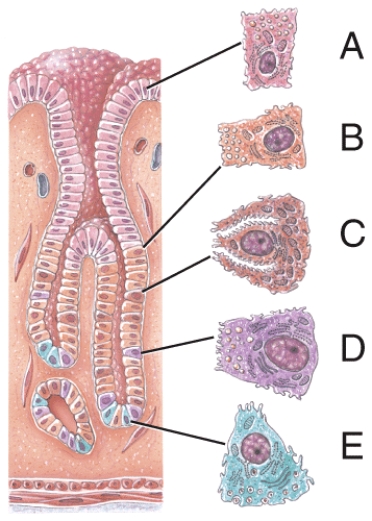
A)A
B)B
C)C
D)D
E)E

A)A
B)B
C)C
D)D
E)E

Unlock Deck
Unlock for access to all 85 flashcards in this deck.
Unlock Deck
k this deck
43
This has an opening called the apical foramen. 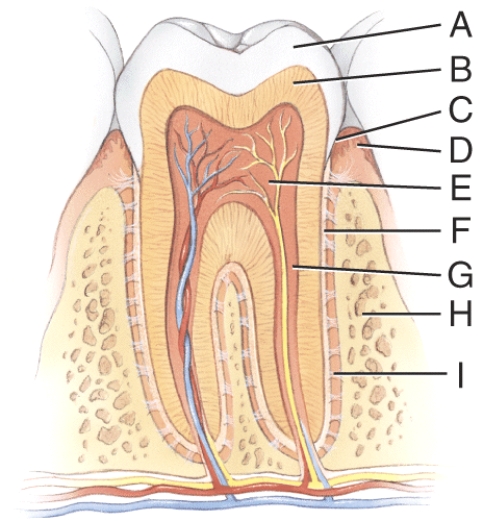
A)A
B)F
C)G
D)H
E)I

A)A
B)F
C)G
D)H
E)I

Unlock Deck
Unlock for access to all 85 flashcards in this deck.
Unlock Deck
k this deck
44
Which of the following cells secretes intrinsic factor? 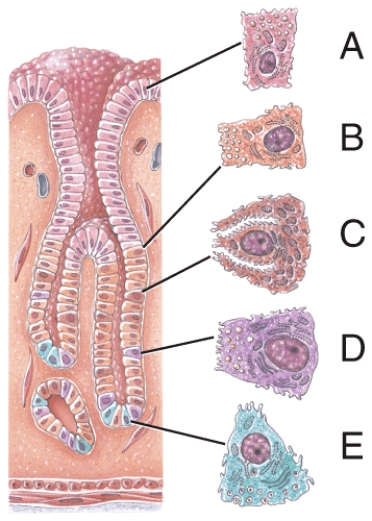
A)A
B)B
C)C
D)D
E)E

A)A
B)B
C)C
D)D
E)E

Unlock Deck
Unlock for access to all 85 flashcards in this deck.
Unlock Deck
k this deck
45
What is line A pointing to? 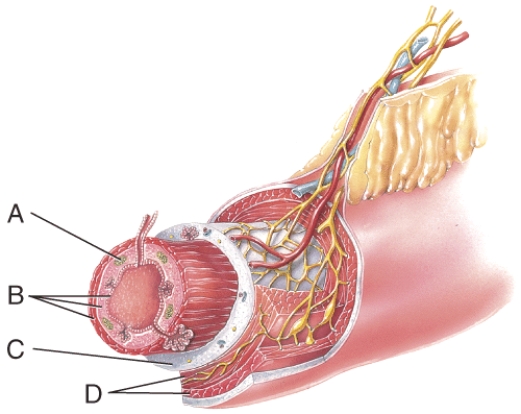
A)Lumen
B)MALT
C)Mucosa
D)Submucosa
E)Muscularis

A)Lumen
B)MALT
C)Mucosa
D)Submucosa
E)Muscularis

Unlock Deck
Unlock for access to all 85 flashcards in this deck.
Unlock Deck
k this deck
46
Which layer contains the lamina propria? 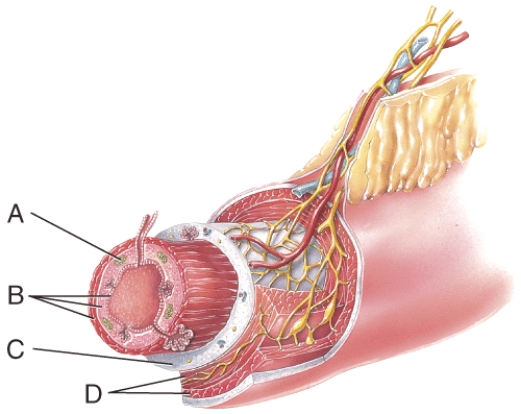
A)A
B)B
C)C
D)D
E)E

A)A
B)B
C)C
D)D
E)E

Unlock Deck
Unlock for access to all 85 flashcards in this deck.
Unlock Deck
k this deck
47
This is the area where pyloric stenosis occurs. 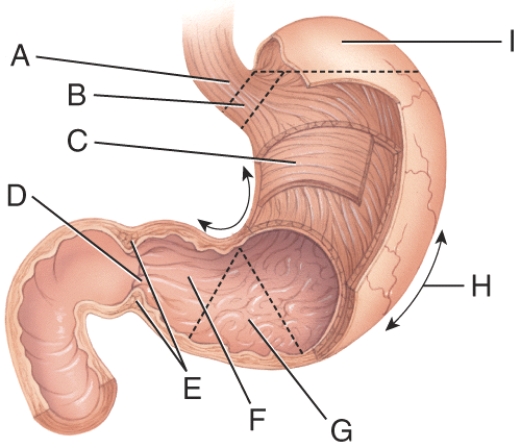
A)E
B)F
C)G
D)B
E)I

A)E
B)F
C)G
D)B
E)I

Unlock Deck
Unlock for access to all 85 flashcards in this deck.
Unlock Deck
k this deck
48
What is line F pointing to? 
A)Pulp cavity
B)Cementum
C)Root canal
D)Alveolar bone
E)Gingival sulcus

A)Pulp cavity
B)Cementum
C)Root canal
D)Alveolar bone
E)Gingival sulcus

Unlock Deck
Unlock for access to all 85 flashcards in this deck.
Unlock Deck
k this deck
49
Which of the following cells secrete mucus? 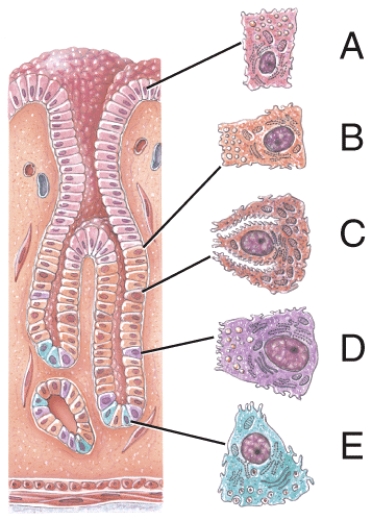
A)B
B)C
C)D
D)E

A)B
B)C
C)D
D)E

Unlock Deck
Unlock for access to all 85 flashcards in this deck.
Unlock Deck
k this deck
50
Explain why food does not normally go up into your nasal cavity or down into your lungs when you swallow-even if you are standing on your head when you swallow.

Unlock Deck
Unlock for access to all 85 flashcards in this deck.
Unlock Deck
k this deck
51
This consists of calcified connective tissue. 
A)A
B)B
C)E
D)F
E)G

A)A
B)B
C)E
D)F
E)G

Unlock Deck
Unlock for access to all 85 flashcards in this deck.
Unlock Deck
k this deck
52
What does line G point to? 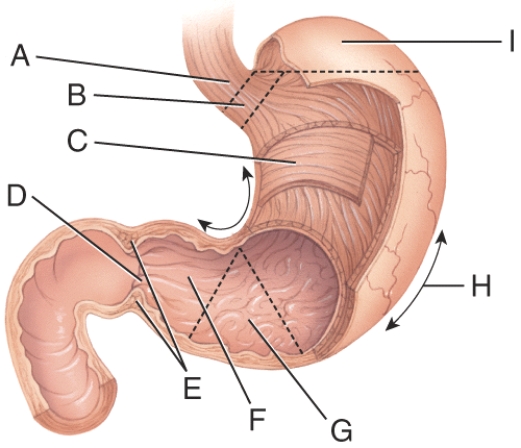
A)Pylorus
B)Pyloric sphincter
C)Rugae
D)Pyloric antrum
E)Greater curvature

A)Pylorus
B)Pyloric sphincter
C)Rugae
D)Pyloric antrum
E)Greater curvature

Unlock Deck
Unlock for access to all 85 flashcards in this deck.
Unlock Deck
k this deck
53
Identify the protein-hydrolyzing enzymes in the digestive tract,and name their sources.Why are these enzymes released in an inactive form?

Unlock Deck
Unlock for access to all 85 flashcards in this deck.
Unlock Deck
k this deck
54
Which of the following cells secretes pepsinogen? 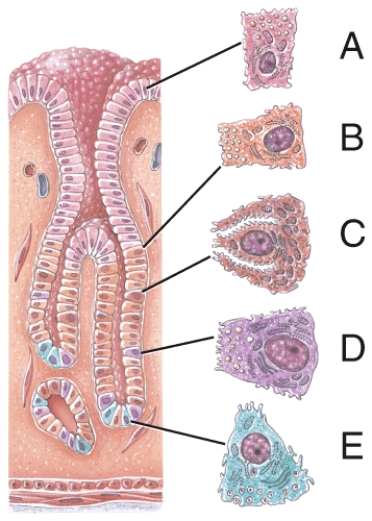
A)A
B)B
C)C
D)D
E)E

A)A
B)B
C)C
D)D
E)E

Unlock Deck
Unlock for access to all 85 flashcards in this deck.
Unlock Deck
k this deck
55
Which of the following is NOT a primary function of the large intestine?
A)Mechanical digestion
B)Chemical digestion
C)Absorption
D)Feces formation
E)Regulation of blood glucose
A)Mechanical digestion
B)Chemical digestion
C)Absorption
D)Feces formation
E)Regulation of blood glucose

Unlock Deck
Unlock for access to all 85 flashcards in this deck.
Unlock Deck
k this deck
56
Describe the structures and functions of the enteric nervous system.

Unlock Deck
Unlock for access to all 85 flashcards in this deck.
Unlock Deck
k this deck
57
What is line I pointing to? 
A)Greater curvature
B)Lesser curvature
C)Body
D)Fundus
E)Cardia

A)Greater curvature
B)Lesser curvature
C)Body
D)Fundus
E)Cardia

Unlock Deck
Unlock for access to all 85 flashcards in this deck.
Unlock Deck
k this deck
58
Describe the role of the liver in protein metabolism.

Unlock Deck
Unlock for access to all 85 flashcards in this deck.
Unlock Deck
k this deck
59
This is the portion of the stomach that connects to the duodenum. 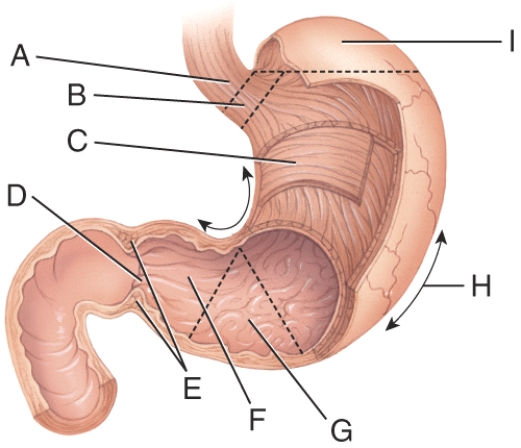
A)A
B)E
C)D
D)B

A)A
B)E
C)D
D)B

Unlock Deck
Unlock for access to all 85 flashcards in this deck.
Unlock Deck
k this deck
60
Describe the structural characteristics of the small intestine that enhance its function as the major absorber of nutrients.

Unlock Deck
Unlock for access to all 85 flashcards in this deck.
Unlock Deck
k this deck
61
Name the structure labeled D 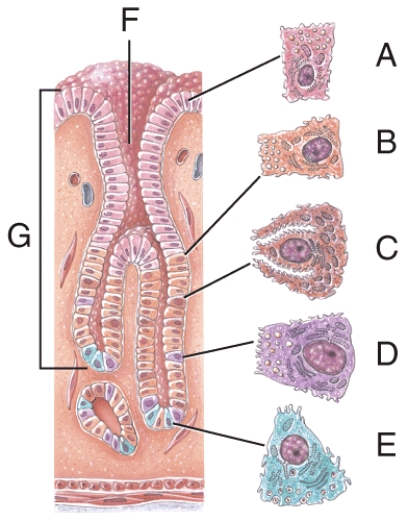
A)Parietal cell
B)Gastric glands
C)Gastric pit
D)Chief cell
E)Simple columnar epithelium

A)Parietal cell
B)Gastric glands
C)Gastric pit
D)Chief cell
E)Simple columnar epithelium

Unlock Deck
Unlock for access to all 85 flashcards in this deck.
Unlock Deck
k this deck
62
The enzyme,produced in the organ labeled D,that produces both glucose and galactose as products is called: 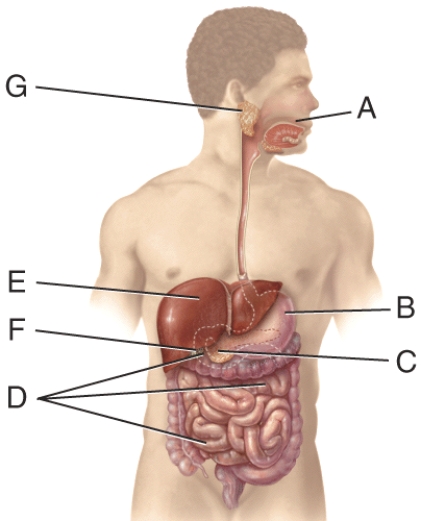
A)lactase
B)pancreatic lipase
C)sucrase
D)pepsin
E)nucleases

A)lactase
B)pancreatic lipase
C)sucrase
D)pepsin
E)nucleases

Unlock Deck
Unlock for access to all 85 flashcards in this deck.
Unlock Deck
k this deck
63
Name the structure labeled G 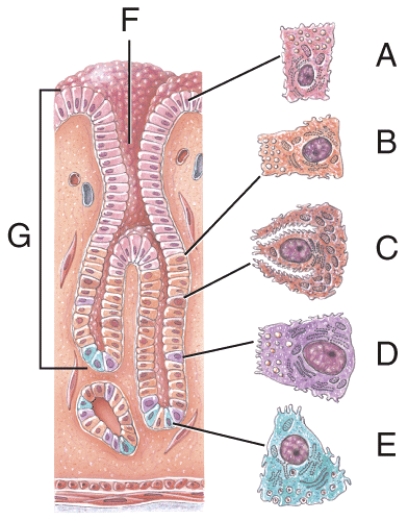
A)Parietal cell
B)Gastric glands
C)Gastric pit
D)Chief cell
E)Simple columnar epithelium

A)Parietal cell
B)Gastric glands
C)Gastric pit
D)Chief cell
E)Simple columnar epithelium

Unlock Deck
Unlock for access to all 85 flashcards in this deck.
Unlock Deck
k this deck
64
Name the structure labeled F 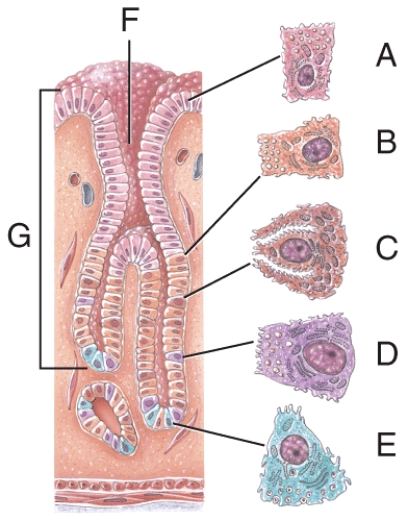
A)Parietal cell
B)Gastric glands
C)Gastric pit
D)Chief cell
E)Simple columnar epithelium

A)Parietal cell
B)Gastric glands
C)Gastric pit
D)Chief cell
E)Simple columnar epithelium

Unlock Deck
Unlock for access to all 85 flashcards in this deck.
Unlock Deck
k this deck
65
The enzyme,active in the organ labeled D,that has starches as a substrate is: 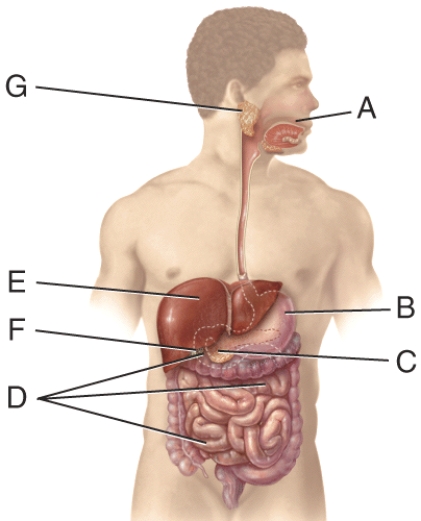
A)Trypsin
B)Salivary amylase
C)Ribonuclease
D)α-dextrinase
E)Pancreatic amylase

A)Trypsin
B)Salivary amylase
C)Ribonuclease
D)α-dextrinase
E)Pancreatic amylase

Unlock Deck
Unlock for access to all 85 flashcards in this deck.
Unlock Deck
k this deck
66
Name the layer labeled A 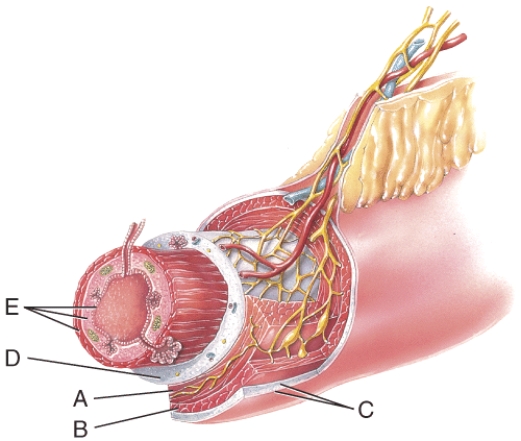
A)Submucosa
B)Serosa
C)Longitudinal muscle
D)Mucosa
E)Circular muscle

A)Submucosa
B)Serosa
C)Longitudinal muscle
D)Mucosa
E)Circular muscle

Unlock Deck
Unlock for access to all 85 flashcards in this deck.
Unlock Deck
k this deck
67
The enzyme,produced in the organ labeled D,that produces both glucose and fructose as products is called: 
A)lactase
B)pancreatic lipase
C)sucrase
D)pepsin
E)nucleases

A)lactase
B)pancreatic lipase
C)sucrase
D)pepsin
E)nucleases

Unlock Deck
Unlock for access to all 85 flashcards in this deck.
Unlock Deck
k this deck
68
The enzyme,produced in the organ labeled D,that produces only glucose as a product is called: 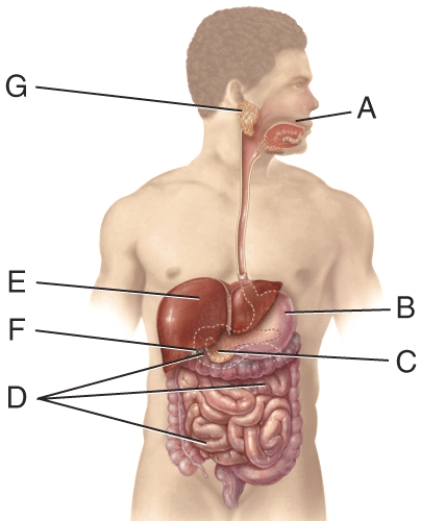
A)maltase
B)pancreatic lipase
C)sucrase
D)pepsin
E)nucleases

A)maltase
B)pancreatic lipase
C)sucrase
D)pepsin
E)nucleases

Unlock Deck
Unlock for access to all 85 flashcards in this deck.
Unlock Deck
k this deck
69
Which enzyme,active in organ D,has nucleotides as a substrate? 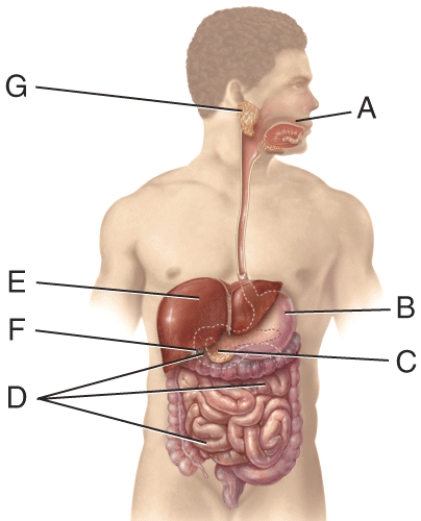
A)nucleases
B)Salivary amylase
C)α-dextrinase
D)nucleosidases
E)pancreatic amylase

A)nucleases
B)Salivary amylase
C)α-dextrinase
D)nucleosidases
E)pancreatic amylase

Unlock Deck
Unlock for access to all 85 flashcards in this deck.
Unlock Deck
k this deck
70
Name the structure labeled C 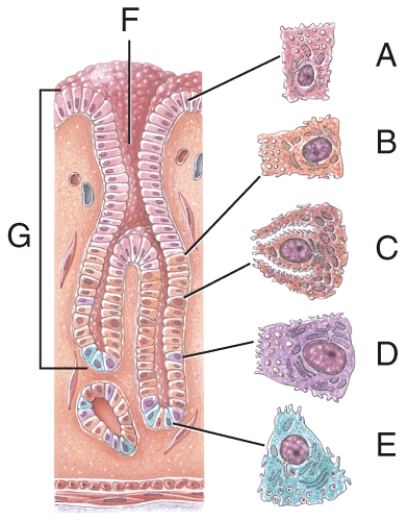
A)Parietal cell
B)Gastric glands
C)Gastric pit
D)Chief cell
E)Simple columnar epithelium

A)Parietal cell
B)Gastric glands
C)Gastric pit
D)Chief cell
E)Simple columnar epithelium

Unlock Deck
Unlock for access to all 85 flashcards in this deck.
Unlock Deck
k this deck
71
Name the layer labeled E 
A)Submucosa
B)Serosa
C)Longitudinal muscle
D)Mucosa
E)Circular muscle

A)Submucosa
B)Serosa
C)Longitudinal muscle
D)Mucosa
E)Circular muscle

Unlock Deck
Unlock for access to all 85 flashcards in this deck.
Unlock Deck
k this deck
72
The enzyme produced in the organ labeled C which digests DNA is called: 
A)Deoxyribonuclease
B)Ribonuclease
C)Salivary amylase
D)Pepsin
E)sucrase

A)Deoxyribonuclease
B)Ribonuclease
C)Salivary amylase
D)Pepsin
E)sucrase

Unlock Deck
Unlock for access to all 85 flashcards in this deck.
Unlock Deck
k this deck
73
Which enzyme,active in organ D,has nucleotides as a substrate? 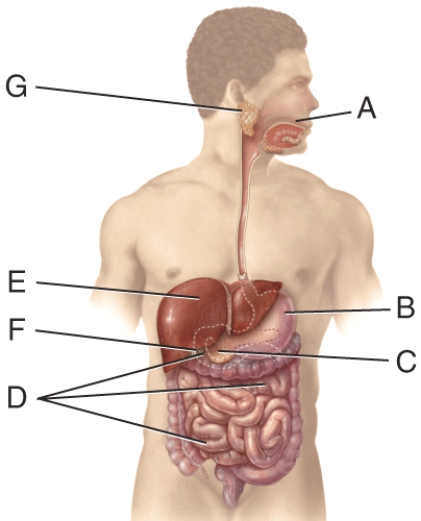
A)ribonuclease
B)salivary amylase
C)phosphatases
D)α-dextrinase
E)Pancreatic amylase

A)ribonuclease
B)salivary amylase
C)phosphatases
D)α-dextrinase
E)Pancreatic amylase

Unlock Deck
Unlock for access to all 85 flashcards in this deck.
Unlock Deck
k this deck
74
The enzyme,produced in the organ labeled C,that produces fatty acids and monoglycerides during digestion is called: 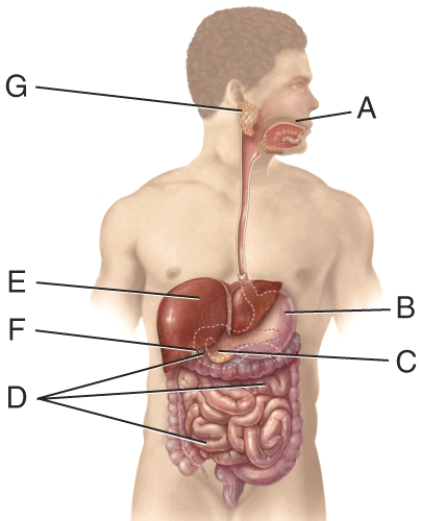
A)Sucrase
B)Pancreatic lipase
C)Salivary amylase
D)Trypsin
E)Elastase

A)Sucrase
B)Pancreatic lipase
C)Salivary amylase
D)Trypsin
E)Elastase

Unlock Deck
Unlock for access to all 85 flashcards in this deck.
Unlock Deck
k this deck
75
Name the layer labeled C 
A)Submucosa
B)Serosa
C)Longitudinal muscle
D)Mucosa
E)Circular muscle

A)Submucosa
B)Serosa
C)Longitudinal muscle
D)Mucosa
E)Circular muscle

Unlock Deck
Unlock for access to all 85 flashcards in this deck.
Unlock Deck
k this deck
76
Which of the following disorders results in an enlargement of the organ labeled G? 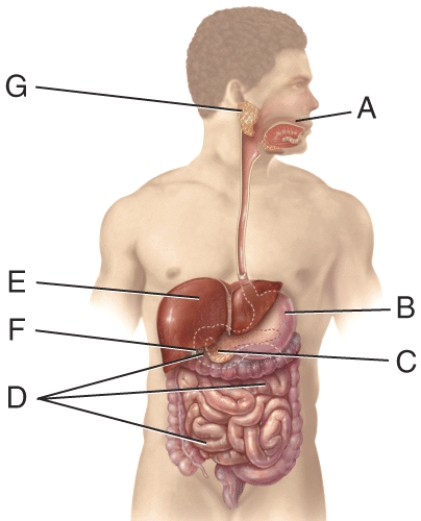
A)peritonitis
B)heartburn
C)mumps
D)vomiting
E)pancreatitis

A)peritonitis
B)heartburn
C)mumps
D)vomiting
E)pancreatitis

Unlock Deck
Unlock for access to all 85 flashcards in this deck.
Unlock Deck
k this deck
77
An enzyme,produced in the organ labeled D,that produces only glucose as a product is called: 
A)pancreatic lipase
B)sucrase
C)lactase
D)α-dextrinase
E)chymotrypsin

A)pancreatic lipase
B)sucrase
C)lactase
D)α-dextrinase
E)chymotrypsin

Unlock Deck
Unlock for access to all 85 flashcards in this deck.
Unlock Deck
k this deck
78
Name the layer labeled D 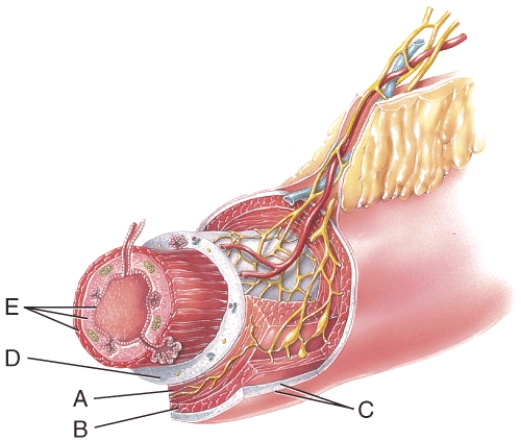
A)Submucosa
B)Serosa
C)Longitudinal muscle
D)Mucosa
E)Circular muscle

A)Submucosa
B)Serosa
C)Longitudinal muscle
D)Mucosa
E)Circular muscle

Unlock Deck
Unlock for access to all 85 flashcards in this deck.
Unlock Deck
k this deck
79
The enzyme produced in the organ labeled C which digests RNA is called: 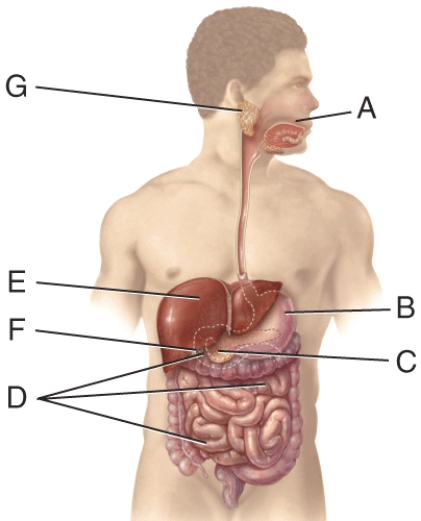
A)Sucrase
B)Deoxyribonuclease
C)Salivary amylase
D)Ribonuclease
E)Pepsin

A)Sucrase
B)Deoxyribonuclease
C)Salivary amylase
D)Ribonuclease
E)Pepsin

Unlock Deck
Unlock for access to all 85 flashcards in this deck.
Unlock Deck
k this deck
80
Name the layer labeled B 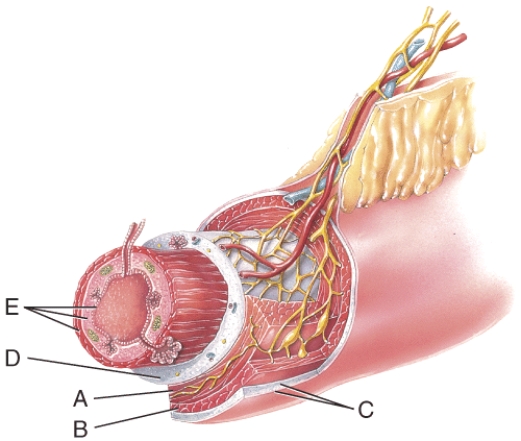
A)Submucosa
B)Serosa
C)Longitudinal muscle
D)Mucosa
E)Circular muscle

A)Submucosa
B)Serosa
C)Longitudinal muscle
D)Mucosa
E)Circular muscle

Unlock Deck
Unlock for access to all 85 flashcards in this deck.
Unlock Deck
k this deck



